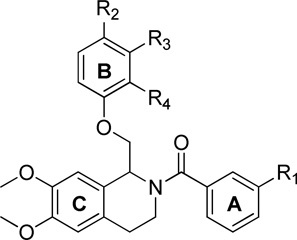Table 2.
Optimization of substituent placement on Ring B.
 | ||||||||
|---|---|---|---|---|---|---|---|---|
| I10 µM / ICONTROL (mean ± SEM, %) |
EC50 (maximal potentiation) (µM, %)a |
|||||||
| R1 | R2 | R3 | R4 | GluN2C | GluN2D | GluN2C | GluN2D | |
| 89 | H | H | H | H | 95 ± 2.6 | 99 ± 1.9 | -- | -- |
| 1 | H | OMe | H | H | 116 ± 2.9 | 123 ± 2.3 | 12 (145%) | 11 (156%) |
| 90 | H | H | OMe | H | 95 ± 2.2 | 92 ± 1.5 | -- | -- |
| 196 | H | H | H | OMe | 94 ± 3.7 | 95 ± 2.5 | -- | -- |
| 2 | Cl | OMe | H | H | 193 ± 7.3 | 179 ± 5.7 | 4.6 (233%) | 5.0 (215%) |
| 91 | Cl | H | OMe | H | 100 ± 2.0 | 96 ± 1,4 | -- | -- |
| 92 | Cl | H | H | OMe | 91 ± 2.2 | 97 ± 1.1 | -- | -- |
Fitted EC50 values are shown to two significant digits when potentiation at 10 µM test compound exceeded 115%; values in parentheses are the fitted maximum response as a percentage of the initial glutamate (100 µM) and glycine (30 µM) response. Compounds 1 and 2 were also shown in Table 1, and are included here for comparison. Data are from between 6–25 oocytes from between 2–4 frogs for each compound and receptor tested.
